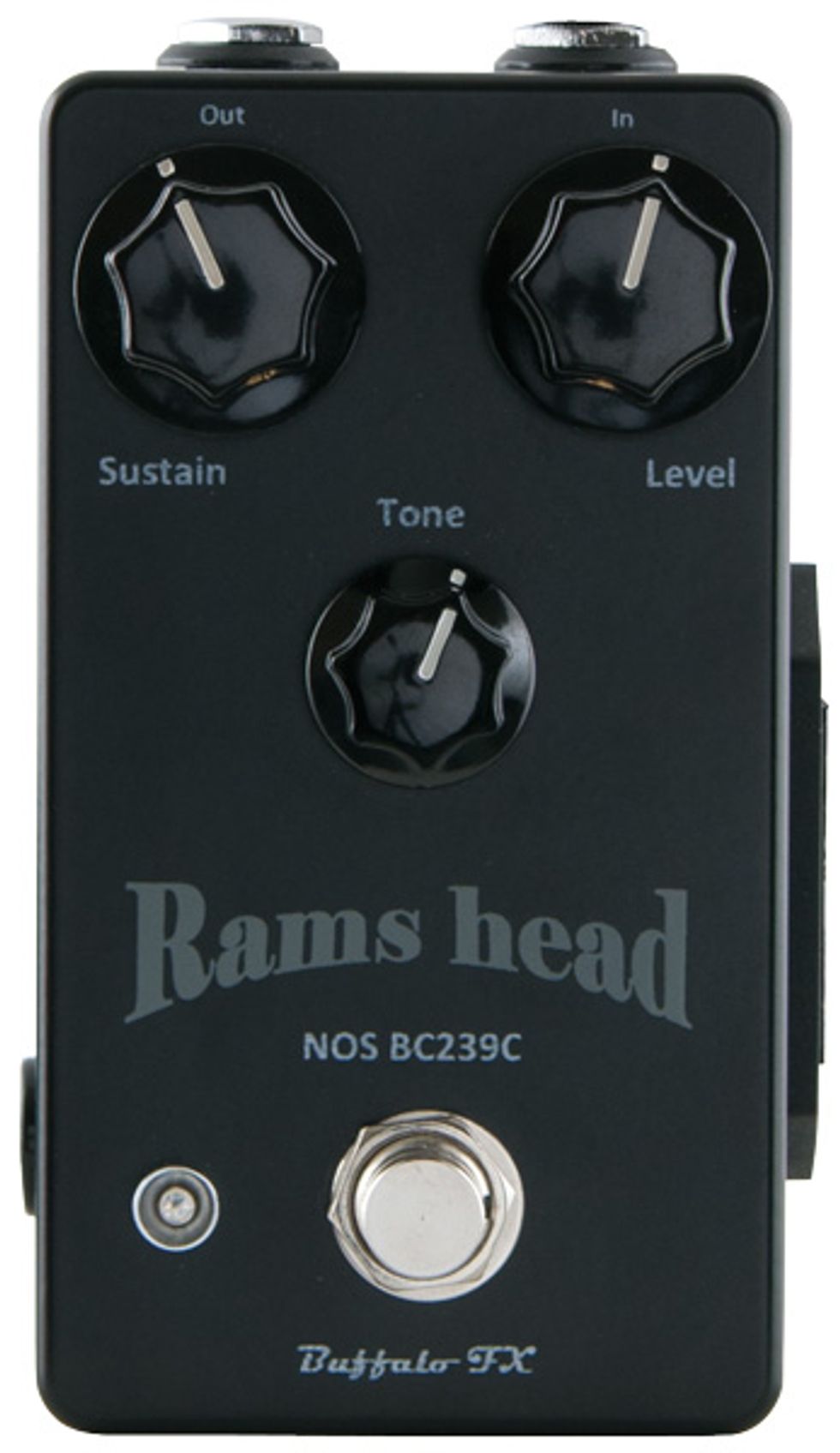If you line up a several original “ram’s head” Big Muffs, each will speak with a slightly different accent. Electro-Harmonix allegedly used some 20 different schematics for this second version of the Muff, which the company introduced in 1973. One constant among originals, however, is their midrange scoop, which can make the Muff a shadowy presence in a live situation.
Precision Muffin Makin’ Steve Painter of Buffalo FX says that addressing this midrange drop was the first priority of his ram’s head clone, and indeed, his NOS BC239C transistor-driven unit has a perceptible midrange bump and increased top-end headroom. The components are period-accurate—everything inside this black box existed in the ’70s.
It’s a beautifully built box too. The Buffalo FX Ram’s Head uses the same enclosure as Painter’s last fuzz, the Germanium. It’s taller than most pedals, which may take some getting used to. One reason for the unusual enclosure is a quick-release 9-volt battery drawer, which might remind Muff fanatics of Pete Cornish’s famous clones. No need to fuss with wires or connectors—just slide the battery into place. (You can also power the pedal with a center-negative 9-volt barrel adaptor.)
The straightforward controls mirror the original: sustain, level, and tone. Input and output jacks are at the crown of the box, and there’s a small blue power indicator LED next to the footswitch.
Ratings
Pros:
Excellent Muff-style leads with extra midrange to cut through the mix.
Cons:
Enclosure can be a bit awkward/blocky on a crowded pedalboard.
Tones:
Ease of Use:
Build:
Value:
Street:
$205
Buffalo FX Ram's Head
buffalofx.com
Stepping Out of the Shadows Because the original Ram’s Head is so closely associated with David Gilmour’s tones from Animals and The Wall, I hooked up a Stratocaster and an Orange OR50 with EL34s to approximate Gilmour’s classic rig. Running a clean output on the amp, I engaged the Ram’s Head with sustain maxed. This setting was a bit aggressive for most of Gilmour’s leads, but dialing back the gain to 3 o’clock let me nail the sustained bends from “Dogs.” However, the maximum-sustain setting proved excellent for mining Tony Iommi’s Vol. 4 lead tones, especially after adding a slight tone bump and switching to a Les Paul with humbuckers. The extra dirt lends a gritty bite to metal-tinged solos without inducing overwhelming feedback.
In a full-band setting, the Buffalo was a revelation. You sometimes need an extra overdrive or EQ pedal to make a Muff heard within a raging band, but not with the Ram’s Head. Painter’s tweaks provide a hot edge that cuts through dense band arrangements with output to spare. Even paired with a dark, reverb-drenched Fender Twin Reverb, the Ram’s Head easily finds a toehold for lead work or rhythm riffing. I performed an A/B test between the Buffalo and several other Muff-style pedals lurking around my rehearsal space, and the advantages of Painter’s mods shone brightly. The Buffalo usually sounded slightly cleaner, with greater midrange clarity.
The Verdict This is the second Buffalo FX fuzz box I’ve reviewed, and my expectations were high. Steve Painter hand-wires, assembles, tests and screen-prints each box, and his dedication shows. The Buffalo FX Ram’s Head’s added midrange presence increases the circuit’s versatility without sacrificing the power you want from a Muff. It’s equally happy with single-coils and humbuckers, and sounds great through both American- and British-style amps. In fact, you’d be hard pressed to find a rig this Ram’s Head won’t work with.








![Rig Rundown: Russian Circles’ Mike Sullivan [2025]](https://www.premierguitar.com/media-library/youtube.jpg?id=62303631&width=1245&height=700&quality=70&coordinates=0%2C0%2C0%2C0)

















